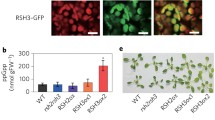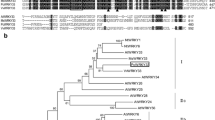Abstract
The common ice plant, Mesembryanthemum crystallinum, shifts from C3 to crassulacean acid metabolism (CAM) photosynthesis in response to osmotic stress. The expression of a number of genes encoding enzymes involved in the CAM pathway increases as a result of increased transcription rates. To begin to investigate the mechanisms responsible for the transcriptional activation, we have characterized the 5′ control region of a specific isoform of phosphoenolpyruvate carboxylase gene (Ppc1) that plays a key role in CAM. We have determined the nucleotide sequence of the 5′ flanking region of this gene. Ppc1 contains a long 5′-leader sequence with the transcriptional start site located 332/333 nucleotides 5′ of the translational initiation codon. Multiple DNA interactions with nuclear factors are detectable within the 5′-flanking region of Ppc1. We have used copper orthophenanthroline footprinting to demonstrate that one particularly abundant factor (designated PCAT-1) binds the Ppc1 promoter at two distinct A/T-rich sites located −128 to −158 and −187 to −205 bp upstream of the transcriptional start site. These binding sites share a loose consensus motif having the sequence AARTAAC(T/A)A(G/T)TTTY. Gel retardation competition experiments with oligonucleotides containing these A/T-rich binding sites suggest that both sites bind the same factor, but with different affinities. Fractionation of crude nuclear extracts by heparin-agarose chromatography indicates that PCAT-1 is more prevalent in extracts prepared from salt-stressed leaf tissue. Additional binding activities that interact with the PCAT-1 binding sites have been detected that either increase or decrease in abundance or binding affinity in response to salt stress.
Similar content being viewed by others
References
Blumenthal T, Landers TA: The inhibition of nucleic acid-binding proteins by aurentricarboxylic acid. Biochem Biophys Res Comm 55: 680–688 (1973).
Bohnert HJ, Ostrem JA, Cushman JC, Michalowski CB, Rickers J, Meyer G, DeRocher EJ, Vernon DM, Krueger M, Vazquez-Moreno L, Velten J, Höfner R, Schmitt JM: Mesembryanthemum crystallinum, a higher plant model system for the study of environmentally induced changes in gene expression. Plant Mol Biol Rep 6: 10–28 (1988).
Benton WD, Davis RW: Screening Lambda gt recombinant clones by hybridization to single plaques in situ. Science 196: 180–182.
Bustos MM, Guiltinan MJ, Jordano J, Begum D, Kalkan FA, Hall TC: Regulation of β-glucuronidase expression in transgenic tobacco plants by an A/T-rich, cis-acting sequence found upstream of a french bean β-phaseolin gene. Plant Cell 1: 839–853 (1989).
Bustos MM, Begum D, Kalkan FA, Battraw MJ, Hall TC: Positive and negative cis-acting DNA domains are required for spatial and temporal regulation of gene expression by a seed storage protein promoter. EMBO J 10: 1469–1479 (1991).
Castresana C, Garcia-Luque I, Alonso E, Malik VS, Cashmore AR: Both positive and negative regulatory elements mediated expression of a photoregulated CAB gene from Nicotiana plumbaginifolia. EMBO J 7: 1929–1936 (1988).
Cushman JC, Meyer G, Michalowski CB, Schmitt JM, Bohnert HJ: Salt stress leads to differential expression of two isogenes of phosphoenolpyruvate carboxylase during Crassulacean acid metabolism induction in the common ice plant. Plant Cell 1: 715–725 (1989).
Cushman JC, Vernon DM, Bohnert HJ: ABA and the transcriptional control of CAM induction during salt stress in the common ice plant. In: Verma DP (ed) Control of Plant Gene Expression, CRC Press Inc., Boca Raton, Florida (1991).
Datta N, Cashmore AR: Binding of a pea nuclear protein to promoters of certain photoregulated genes is modulated by phosphorylation. Plant Cell 1: 1069–1077 (1989).
Forde BG, Freeman J, Oliver JE, Pineda M: Nuclear factors interact with conserved A/T-rich elements upstream of a nodule-enhanced glutamine synthetase gene from French bean. Plant Cell 2: 925–939 (1990).
Fried M, Crothers DM: Equilibria and kinetics of lac repressor-operator interactions by polyacrylamide gel electrophoresis. Nucl Acids Res 9: 6505–6525 (1981).
Garner MM, Revzin A: A gel electrophoresis method for quantifying the binding of proteins to specific DNA regions: application to components of the Escherichia coli lactose operon regulatory system. Nucl Acids Res 9: 3047–3060 (1981).
Grasser KD, Maier U-G, Haass MM, Geix G: Maize high mobility group proteins bind to CCAAT and TATA boxes of a zein gene promoter. J Biol Chem 265: 4185–4188 (1990).
Green PJ, Kay SA, Lam E, Chua N-H: In vitro DNA footprinting. In: Gelvin SB, Schillperoort RA, Verma DPS (eds) Plant Molecular Biology Manual, B11, pp. 1–22. Kluwer Academic Publishers, Dordrecht (1989).
Guiltinan MJ, Marcotte WR, Quatrano RS: A plant leucine zipper protein that recognizes an abscisic acid response element. Science 250: 267–271 (1990).
Holtum JAM, Winter K: Activity of enzymes of carbon metabolism during the induction of Crassulacean acid metabolism in Mesembryanthemum crystallinum L. Planta 155: 8–16 (1982).
Jacobsen K, Laursen NB, Jensen EØ, Marcker A, Poulsen C, Marcker KA: HMG I-like proteins from leaf and nodule nuclei interact with different AT motifs in soybean nodulin promoters. Plant Cell 2: 85–94 (1990).
Jensen EØ, Marcker KA, Schell J, de Bruijn FJ: Interaction of a nodule specific, trans-acting factor with distinct DNA elements in the soybean leghaemoglobin lbc3 5′ upstream region. EMBO J 7: 1265–1271 (1988).
Jofuku KD, Okamuro JK, Goldberg RB: Interaction of an embryo DNA binding protein with a soybean lectin gene upstream region. Nature 328: 734–737 (1987).
Johns EW: History, definitions and problems. In: Johns EW (ed) The HMG Chromosomal Proteins, pp. 1–7. Academic Press, New York (1982).
Joshi CP: An inspection of the domain between putative TATA box and translation start site in 79 plant genes. Nucl Acids Res 15: 6643–6653 (1987).
Jordano J, Almoguera C, Thomas TL: A sunflower helianthinin gene upstream sequence ensemble contains an enhancer and sites of nuclear protein interaction. Plant Cell 1: 855–866 (1989).
Kadonaga JT, Tjian R: Affinity purification of sequence-specific DNA binding proteins. Proc Natl Acad Sci USA 83: 5889–5893 (1986).
Kluge M, Ting IP: Crassulacean Acid Metabolism. Analysis of an ecological adaptation. In: Ecological Studies, vol. 30, pp. 209. Springer-Verlag, Heidelberg (1978).
Kozak M: An analysis of 5′-noncoding sequences from 699 vertebrate messenger RNAs. Nucl Acids Res 15: 8125–8148 (1987).
Kozak M: Leader length and secondary structure modulate mRNA function under conditions of stress. Mol Cell Biol 8: 2737–2744 (1988).
Kuwabara MD, Sigman DS: Footprinting DNA-protein complexes in situ following gel retardation assays using 1,10-phenanthroline-copper ion: Escherichia coli RNA polymerase-lac promoter complexes. Biochemistry 26: 363–375 (1987).
Lam E, Kano-Murakami Y, Gilmartin P, Niner B, Chua N-H: A metal-dependent DNA-binding protein interacts with a constitutive element of a light-responsive promoter. Plant Cell 2: 857–866 (1990).
Lütcke HA, Chow KC, Mickel FS, Moss KA, Kern HF, Scheele GA: Selection of AUG initiation codons differs in plants and animals. EMBO J 6: 43–48 (1987).
Maxam AM, Gilbert W: Sequencing end-labeled DNA with base-specific chemical cleavages. Meth Enzymol 65: 499–560 (1980).
Maniatis T, Fritsch EF, Sambrook J: Molecular cloning: a laboratory manual. Cold Spring Harbor Laboratory, Cold Spring Harbor, NY (1982).
Manzara T, Carrasco P, Gruissem W: Developmental and organ-specific changes in promoter DNA-protein interactions in the tomato rbcS gene family. Plant Cell 3: 1305–1316 (1991).
Metz BA, Welters P, Hoffmann HJ, Jensen EØ, Schell J, de Bruijn FJ: Primary structure and promoter analysis of leghemoglobin genes of the stem-nodulated tropical legume Sesbania rostrata: Conserved coding sequences, cis-elements, and trans-acting factors. Mol Gen Genet 214: 181–191 (1988).
Michalowski CB, Olson SW, Piepenbrock M, Schmitt JM, Bohnert HJ: Time course of mRNA induction elicited by salt stress in the common ice plant (Mesembryanthemum crystallinum). Plant Physiol 89: 811–816 (1989).
Osmond CB: Crassulacean acid metabolism: a curiosity in context. Annu Rev Plant Physiol 33: 379–414 (1978).
Ostrem JA, Vernon DM, Bohnert HJ: Increased expression of a gene coding for NAD: Glyceraldehyde-3-phosphate dehydrogenase during the transition from C3 photosynthesis to Crassulacean acid metabolism in Mesembryanthemum crystallinum. J Biol Chem 265: 3497–3502 (1990).
Pedersen TJ, Arwood LJ, Spiker S, Guiltinan MJ, Thompson WF: High mobility group chromosomal proteins bind to AT-rich tracts flanking plant genes. Plant Mol Biol 16: 95–104 (1991).
Riggs CD, Voelker TA, Chrispeels MJ: Cotyledon nuclear proteins bind to DNA fragments harboring regulatory elements of phytohemagglutinin genes. Plant Cell 1: 609–921 (1989).
Stougaard J, Sandal NN, Grøn A, Kühle A, Marcker KA: 5′ Analysis of the soybean leghaemoglobin lbc3 gene: regulatory elements required for promoter activity and organ specificity. EMBO J 6: 3565–3569 (1987).
Ting IP: Crassulacean acid metabolism. Annu Rev Plant Physiol 36: 595–622 (1985).
Timko MP, Kausch AP, Castresana C, Fassler J, Herrera-Estrella L, Van den Broeck G, Van Montagu M, Schell J, Cashmore AR: Light regulation of plant gene expression by an upstream enhancer-like element. Nature 318: 579–582 (1985).
Watson JC, Thompson WF: Purification and restriction analysis of plant nuclear DNA. Meth Enzymol 118: 57–75 (1986).
Watt F, Molloy PL: High mobility group proteins 1 and 2 stimulate binding of a specific transcription factor to the adenovirus major late promoter. Nucl Acids Res 16: 1471–1486 (1988).
Wells RD, Collier DA, Hanvey JC, Shimizu M, Wohlrab F: The chemistry and biology of unusual DNA structures adopted by oligopurine oligopyrimidine sequences. FASEB J 2: 2939–2949 (1988).
Author information
Authors and Affiliations
Rights and permissions
About this article
Cite this article
Cushman, J.C., Bohnert, H.J. Salt stress alters A/T-rich DNA-binding factor interactions within the phosphoenolpyruvate carboxylase promoter from Mesembryanthemum crystallinum . Plant Mol Biol 20, 411–424 (1992). https://doi.org/10.1007/BF00040601
Received:
Accepted:
Issue Date:
DOI: https://doi.org/10.1007/BF00040601




